
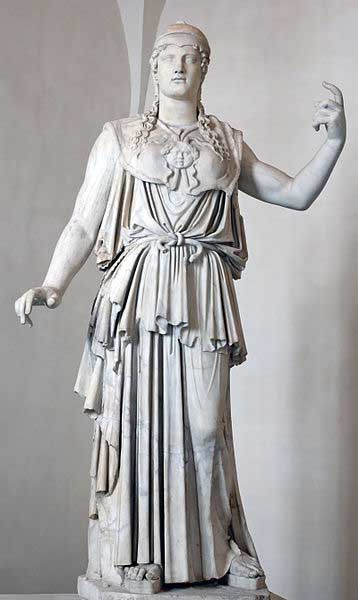


In Greek mythology, Athena, also referred to as Pallas Athena, is the goddess of wisdom, courage, inspiration, civilization, law and justice, just warfare, mathematics, strength, strategy, the arts, crafts, and skill. Minerva, Athena's Roman incarnation, embodies similar attributes. Athena is also a shrewd companion of heroes and is the goddess of heroic endeavor. She is the virgin patroness of Athens. The Athenians founded the Parthenon on the Acropolis of her namesake city, Athens (Athena Parthenos), in her honor.
Athena's veneration as the patron of Athens seems to have existed from the earliest times, and was so persistent that archaic myths about her were recast to adapt to cultural changes. In her role as a protector of the city (polis), many people throughout the Greek world worshiped Athena as Athena Polias ("Athena of the city"). The city of Athens and the goddess Athena essentially bear the same name, "Athenai" meaning "many Athenas".
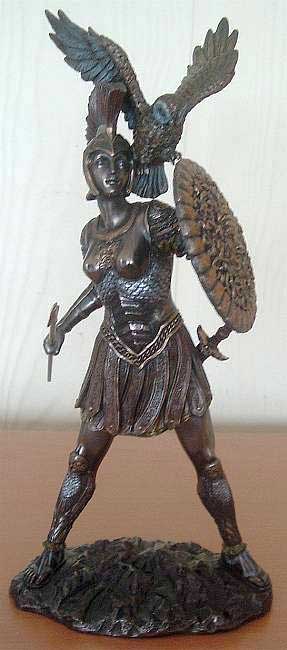
She is attended by an owl, and is often accompanied by the goddess of victory, Nike. Wearing a goatskin breastplate called the Aegis given to her by her father, Zeus, she is often shown helmeted and with a shield bearing the Gorgon Medusa's head, a votive gift of Perseus.
Athena is an armed warrior goddess, and appears in Greek mythology as a helper of many heroes, including Heracles, Jason, and Odysseus. In classical myth she never had a consort or lover, and thus was often known as Athena Parthenos ("Athena the virgin"), hence her most famous temple, the Parthenon, on the Acropolis in Athens. In a remnant of archaic myth, she was the mother of Erichthonius by an attempted rape, which failed.
In her role as a protector of the city, Athena was worshiped throughout the Greek world as Athena Polias ("Athena of the city"). She had a special relationship with Athens, as is shown by the etymological connection of the names of the goddess and the city.
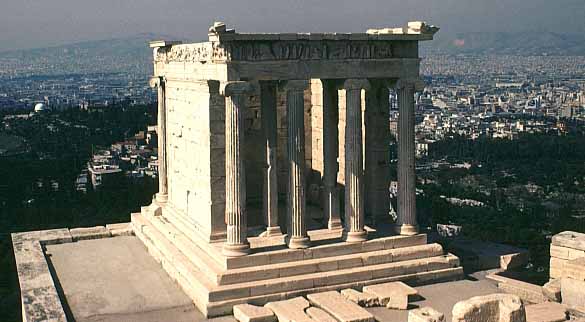
The Greek philosopher, Plato (429-347 BC), identified her with the Libyan deity Neith, the war goddess and huntress deity of the Egyptians since the ancient Pre-Dynastic period, who was also identified with weaving. This is sensible, as some Greeks identified Athena's birthplace, in certain mythological renditions, as being beside Libya's Triton River.
Scholar Martin Bernal created the controversial "Black Athena Theory" to explain this associated origin by claiming that the conception of Neith was brought to Greece from Egypt, along with "an enormous number of features of civilization and culture in the third and second millennia."
Athena as the goddess of philosophy became an aspect of the cult in Classical Greece during the late 5th century BC. She is the patroness of various crafts, especially of weaving, as Athena Ergane. The metalwork of weapons also fell under her patronage. She led battles (Athena Promachos or the warrior maiden Athena Parthenos) as the disciplined, strategic side of war, in contrast to her brother Ares, the patron of violence, bloodlust and slaughter - "the raw force of war". Athena's wisdom includes the cunning intelligence (metis) of such figures as Odysseus. Not only was this version of Athena the opposite of Ares in combat, it was also the polar opposite of the serene earth goddess version of the deity, Athena Polias.
Athena appears in Greek mythology as the patron and helper of many heroes, including Odysseus, Jason, and Heracles.
In Classical Greek myths, she never consorts with a lover, nor does she ever marry, earning the title Athena Parthenos. A remnant of archaic myth depicts her as the adoptive mother of Erechtheus/Erichthonius through the foiled rape by Hephaestus. Other variants relate that Erichthonius, the serpent that accompanied Athena, was born to Gaia: when the rape failed, the semen landed on Gaia and impregnated her. After Erechthonius was born, Gaia gave him to Athena.
Though Athena is a goddess of war strategy, she disliked fighting without purpose and preferred to use wisdom to settle predicaments. The goddess only encouraged fighting for a reasonable cause or to resolve conflict. As patron of Athens she fought in the Trojan war on the side of the Achaeans.
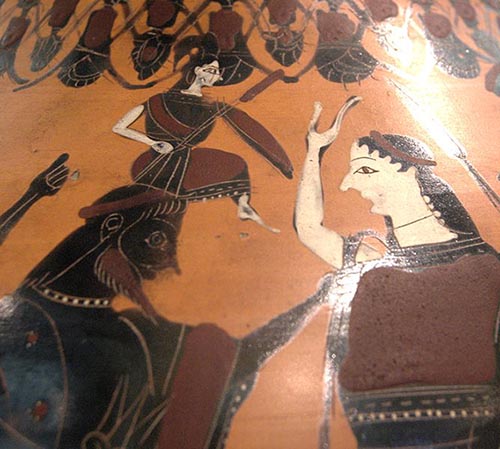
Athena is "born" from Zeus' forehead
Athena was remade as the favorite daughter of Zeus, born fully armed from his forehead after he swallowed her mother, Metis.The story of her birth comes in several versions. In the one most commonly cited, Zeus lay with Metis, the goddess of crafty thought and wisdom, but immediately feared the consequences. It had been prophesied that Metis would bear children more powerful than the sire, even Zeus himself.
In order to forestall these dire consequences, after lying with her, Zeus "put her away inside his own belly;" he "swallowed her down of a sudden," He was too late: Metis had already conceived a child. When it came time, Zeus was in great pain; Prometheus, Hephaestus, Hermes or Palaemon (depending on the sources examined) cleaved Zeus's head with the double-headed Minoan axe, the labrys. Athena leaped from Zeus's head, fully grown and armed with a shout, "and pealed to the broad sky her clarion cry of war.
Hera was so annoyed at Zeus producing a child apparently on his own that she caused herself to conceive and bear Hephaestus by herself. Metis never bore any more children, and Zeus persisted as supreme ruler of Mount Olympus.
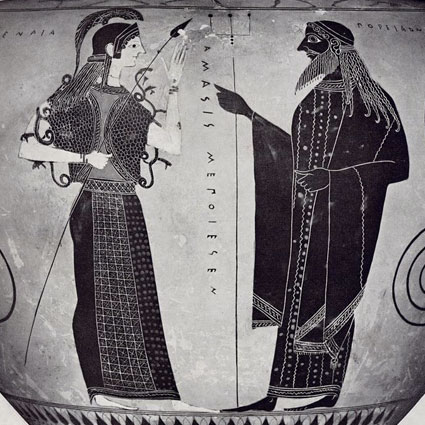
Athena competed with Poseidon to be the patron deity of Athens, which was yet unnamed, in a version of one founding myth. They agreed that each would give the Athenians one gift and that the Athenians would choose the gift they preferred. Poseidon struck the ground with his trident and a salt water spring sprang up; this gave them a means of trade and water - Athens at its height was a significant sea power, defeating the Persian fleet at the Battle of Salamis - but the water was salty and not very good for drinking.
Athena, however, offered them the first domesticated olive tree. The Athenians (or their king, Cecrops) accepted the olive tree and with it the patronage of Athena, for the olive tree brought wood, oil, and food. Robert Graves was of the opinion that "Poseidon's attempts to take possession of certain cities are political myths" which reflect the conflict between matriarchal and patriarchal religions.
Erichthonius
Hephaestus attempted to rape Athena, but she eluded him. His semen fell to the earth and impregnated the soil, and Erichthonius was born from the Earth, Gaia. Athena then raised the baby as a foster mother.
Athena puts the infant Erichthonius into a small box (cista) which she entrusts to the care of three sisters, Herse, Pandrosus, and Aglaulus of Athens. The goddess does not tell them what the box contains, but warns them not to open it until she returns. One or two sisters opens the cista to reveal Erichthonius, in the form (or embrace) of a serpent. The serpent, or insanity induced by the sight, drives Herse and Aglaulus to throw themselves off the Acropolis.[28] Jane Harrison (Prolegomena) finds this to be a simple cautionary tale directed at young girls carrying the cista in the Thesmophoria rituals, to discourage them from opening it outside the proper context.
Another version of the myth of the Athenian maidens is told in Metamorphoses by the Roman poet Ovid (43 BC - 17 AD); in this late variant Hermes falls in love with Herse. Herse, Aglaulus, and Pandrosus go to the temple to offer sacrifices to Athena. Hermes demands help from Aglaulus to seduce Herse. Aglaulus demands money in exchange. Hermes gives her the money the sisters have already offered to Athena. As punishment for Aglaulus's greed, Athena asks the goddess Envy to make Aglaulus jealous of Herse. When Hermes arrives to seduce Herse, Aglaulus stands in his way instead of helping him as she had agreed. He turns her to stone.
With this mythic origin, Erichthonius became the founder-king of Athens, and many beneficial changes to Athenian culture were ascribed to him. During this time, Athena frequently protected him.
Athena instructed Heracles how to remove the skin from the Nemean Lion, by using the lion's own claws to cut through its thick hide. The lion's hide became Heracles' signature garment, along with the olive-wood club he used in the battle. Athena also assisted Heracles on a few other labors. She also helped Heracles defeat the Stymphalian Birds, along with Hephaestus.
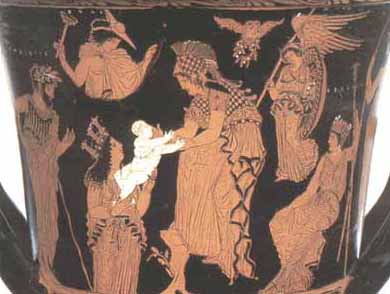
This red-figure vase from ca. 420 BC, depicts the birth of the 'Earth-born One' (Erichthonios). Earth (Gaia) presents the new-born child to Athena, who represents the reborn serpent-friendly Eve after the Flood. The figure to the left of Gaia and the child is Hephaistos, the eldest son of Zeus and Hera, the deified Kain. According to the myth surrounding this event, Athena obtained the sperm, or seed, of Hephaistos (Kain), and placed it into the Earth, and out of Earth sprang the rejuvenated line of Kain after the Flood. The essence of ancient Greek religion is very simple. After the Flood which caused the line of Kain to disappear into the earth, Athena, the reborn serpent-friendly Eve, nurtures the reborn line of Kain which re-emerges from the earth into which it had disappeared.
In a late myth, Medusa, unlike her sister Gorgons, came to be viewed by the Greeks of the 5th century as a beautiful mortal that served as priestess in Athena's temple. Poseidon liked Medusa, and decided to rape her in the temple of Athena, refusing to allow her vow of chastity to stand in his way.[30] Upon discovering the desecration of her temple, Athena changed Medusa's form to match that of her sister Gorgons as punishment. Medusa's hair turned into snakes, her lower body was transformed also, and meeting her gaze would turn any living man to stone. In the earliest myths, there is only one Gorgon, but there are two snakes that form a belt around her waist.
In one version of the Tiresias myth, Tiresias stumbled upon Athena bathing, and he was struck blind by her to ensure he would never again see what man was not intended to see. But having lost his eyesight, he was given a special gift—to be able to understand the language of the birds (and thus to foretell the future).
Athena competed with Poseidon to be the patron deity of Athens, which was yet unnamed in this telling. They agreed that each would give the Athenians one gift and that the Athenians would choose the gift they preferred. Poseidon struck the ground with his trident and a spring sprang up; this gave them a means of trade and water, but it was salty and not very good for drinking.
In an alternate version, Poseidon offered the first horse. Athena, however, offered them the first domesticated olive tree. The Athenians (or their king, Cecrops) accepted the olive tree and along with it Athena as their patron, for the olive tree brought wood, oil and food. This is thought to commemorate a clash between the inhabitants during Mycenaean times and newer immigrants. It is interesting to note that Athens at its height was a significant sea power, defeating the Persian fleet at the Battle of Salamis near Salamis Island in 480 BC. Athena was also the patron goddess of several other cities, notably Sparta.
Later myths of the Classical Greeks relate that Athena guided Perseus in his quest to behead Medusa. She instructed Heracles to skin the Nemean Lion by using its own claws to cut through its thick hide. She also helped Heracles to defeat the Stymphalian Birds, and to navigate the underworld so as to capture Cerberus.
In The Odyssey, Odysseus' cunning and shrewd nature quickly won Athena's favor. In the realistic epic mode, however, she largely is confined to aiding him only from afar, as by implanting thoughts in his head during his journey home from Troy. Her guiding actions reinforce her role as the "protectress of heroes" or as mythologian Walter Friedrich Otto dubbed her the "goddess of nearness" due to her mentoring and motherly probing. It is not until he washes up on the shore of an island where Nausicaa is washing her clothes that Athena arrives personally to provide more tangible assistance. She appears in Nausicaa's dreams to ensure that the princess rescues Odysseus and plays a role in his eventual escort to Ithaca.
Athena appears in disguise to Odysseus upon his arrival, initially lying and telling him that Penelope, his wife, has remarried and that he is believed to be dead; but Odysseus lies back to her, employing skillful prevarications to protect himself. Impressed by his resolve and shrewdness, she reveals herself and tells him what he needs to know in order to win back his kingdom. She disguises him as an elderly man or beggar so that he cannot be noticed by the suitors or Penelope, and helps him to defeat the suitors.
She also plays a role in ending the resultant feud against the suitors' relatives, although she seems strange to readers. She instructs Laertes to throw his spear and to kill the father of Antinous, Eupeithes. But she must have forgotten her task of bringing peace to Ithaca and wiping the thought of slaughter from the suitors' families, because she suddenly told them to stop fighting.
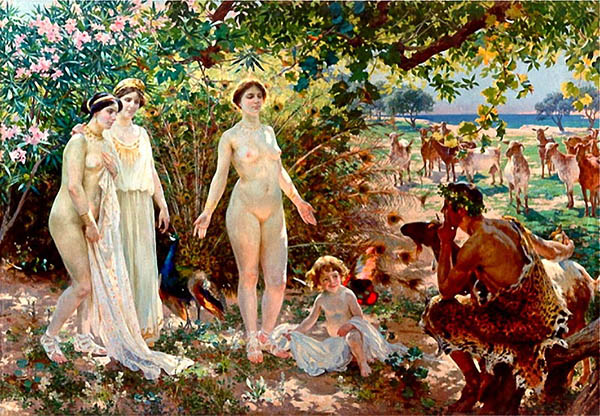
All the gods and goddesses as well as various mortals were invited to the marriage of Peleus and Thetis (the eventual parents of Achilles). Only Eris, goddess of discord, was not invited. She was annoyed at this, so she arrived with a golden apple inscribed with the word "for the fairest", which she threw among the goddesses. Aphrodite, Hera, and Athena all claimed to be the fairest, and thus the rightful owner of the apple.
The goddesses chose to place the matter before Zeus, who, not wanting to favor one of the goddesses, put the choice into the hands of Paris, a Trojan prince. After bathing in the spring of Mount Ida (where Troy was situated), the goddesses appeared before Paris. The goddesses undressed and presented themselves to Paris naked, either at his request or for the sake of winning.
Still, Paris could not decide, as all three were ideally beautiful, so they resorted to bribes. Hera tried to bribe Paris with control over all Asia and Europe, while Athena offered wisdom, fame and glory in battle, but Aphrodite came forth and whispered to Paris that if he were to choose her as the fairest he would have the most beautiful mortal woman in the world as a wife, and he accordingly chose her. This woman was Helen, who was, unfortunately for Paris, already married to King Menelaus of Sparta. The other two goddesses were enraged by this and through Helen's abduction by Paris they brought about the Trojan War.
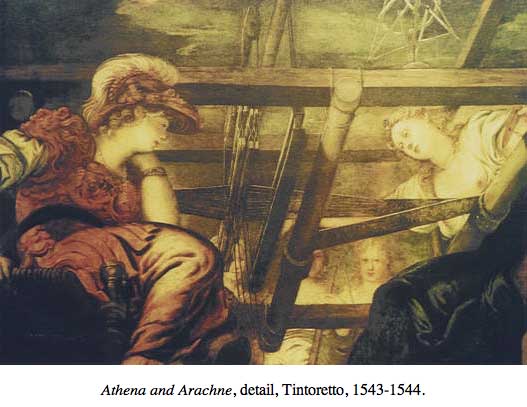
The fable of Arachne is a late addition to Greek mythology, that does not appear in the myth repertory of the Attic vase-painters. Arachne's name simply means "spider". Arachne was the daughter of a famous dyer in Tyrian purple in Hypaipa of Lydia. She became so conceited of her skill as a weaver that she began claiming that her skill was greater than that of Athena herself.
Athena gave Arachne a chance to redeem herself by assuming the form of an old woman and warning Arachne not to offend the gods. Arachne scoffed and wished for a weaving contest, so she could prove her skill. Athena wove the scene of her victory over Poseidon that had inspired her patronage of Athens. According to the Latin narrative, Arachne's tapestry featured twenty-one episodes of the infidelity of the gods: Jupiter being unfaithful with Leda, with Europa, with Danae.
Even Athena admitted that Arachne's work was flawless, but was outraged at Arachne's disrespectful choice of subjects that displayed the failings and transgressions of the gods. Finally losing her temper, Athena destroyed Arachne's tapestry and loom, striking it with her shuttle, Arachne realized her folly and hanged herself.
In Ovid's telling, Athena took pity on Arachne who was changed into a spider. The story suggests that the origin of weaving lay in imitation of spiders and that it was considered to have been perfected first in Asia Minor.
Her epithets included Atrytone (= the unwearying), Parthenos (= virgin), and Promachos (the pre-fighter/-tress, i. e. the person who fights in front).
In poetry from Homer onward, Athena's most common epithet is glaukopis, which is usually translated "bright-eyed" or "with gleaming eyes". It is a combination of glaukos ("gleaming," "silvery," and later, "bluish-green" or "gray") and ops ("eye," or sometimes, "face").
It is interesting to note that glaux "owl") is from the same root, presumably because of its own distinctive eyes. The bird which sees in the night is closely associated with the goddess of wisdom: in archaic images, she is frequently depicted with an owl perched on her head. In earlier times, Athena may well have been a bird goddess, similar to the unknown goddess depicted with owls, wings and bird talons on the Burney relief, a Mesopotamian terracotta relief of the early second millennium BC.
In the Iliad (4.514), the Homeric Hymns and in Hesiod's Theogony, she is given the curious epithet Tritogeneia. The meaning of this term is unclear. It seems to mean "Triton-born," perhaps indicating that the sea-god was her father according to some early myths, or, less likely, that she was born near Lake Triton in Africa. Another possible meaning is "triple-born" or "third-born," which may refer to her status as the third daughter of Zeus or the fact she was born from Metis, Zeus and herself; various legends list her as being the first child after Artemis and Apollo, though other legends identify her as Zeus' first child.
In her role as judge at Orestes' trial on the murder of his mother, Clytemnestra (which he won), Athena won the epithet Athena Areia.
Athena was later associated with the application of philosophy to cult in the fifth century. She remained the patroness of weaving, crafts and the more disciplined side of war. Athena's wisdom encompasses the technical knowledge employed in weaving, metal-working, but also includes the cunning intelligence (metis) of such figures as Odysseus.
The owl and the olive tree are sacred to her. She is attended by an owl, and is often accompanied by the goddess of victory, Nike. Wearing a goatskin breastplate called the Aegis given to her by her father, Zeus, she is often shown helmeted and with a shield bearing the Gorgon Medusa's head, a votive gift of Perseus. Athena is an armed warrior goddess, and appears in Greek mythology as the counselor of many heroes, including Heracles, Jason, and Odysseus.
Athena was given many other cult titles. She had the epithet Athena Ergane as the patron of craftsmen and artisans. With the epithet Athena Parthenos ("virgin"), Athena was worshiped on the Acropolis, especially in the festival of the Panathenaea. With the epithet Athena Promachos she led in battle. With the epithet Athena Polias ("of the city"), Athena was the protectress of Athens and its Acropolis, but also of many other cities, including Argos, Sparta, Gortyn, Lindos, and Larisa. She was given the epithet Athena Hippeia or Athena Hippia as the inventor of the chariot, and was worshipped under this title at Athens, Tegea and Olympia. As Athena Hippeia she was given an alternative parentage: Poseidon and Polyphe, daughter of Oceanus.. In each of these cities her temple was frequently the major temple on the acropolis.
Athena was often equated with Aphaea, a local goddess of the island of Aegina, located near Athens, once Aegina was under Athenian's power. Plutarch also refers to an instance during the Parthenon's construction of her being called Athena Hygieia ("healer"):
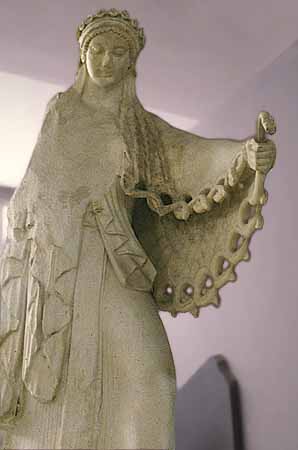
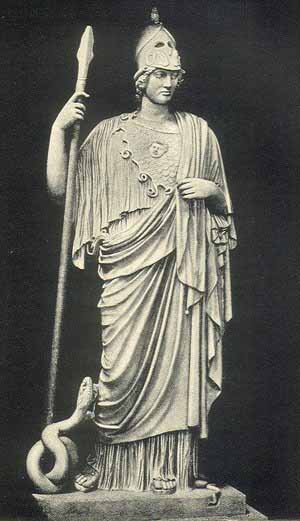
Athena is classically portrayed wearing full armor, with the helmet raised high on the forehead like a hat; she carries a spear and a shield with the head of the gorgon Medusa mounted on it. It is in this standing posture that she was depicted in Phidias's famous lost gold and ivory statue of her, 36 m tall, the Athena Parthenos in the Parthenon. Athena is also often depicted with an owl (a symbol of wisdom) sitting on one of her shoulders.
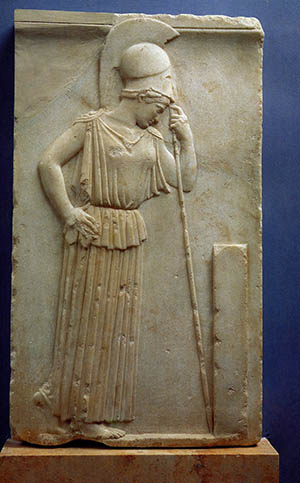
The Mourning Athena is a relief sculpture that dates around 460 BC and portrays a weary Athena resting on a staff. In earlier, archaic portraits of Athena in Black-figure pottery, the goddess retains some of her Minoan character, such as great bird wings, though this is not true of archaic sculpture such as those at Aphaea. Other common types of Athena statue may be found here.
Apart from her attributes, there seems to be a relative consensus in sculpture from the fifth century onward as to what Athena looked like. Most noticeable in the face is perhaps a high nose with a high bridge that almost seems like a natural extension of the forehead. The eyes are typically somewhat deeply set. The lips are usually full but the mouth is fairly narrow, usually just slightly wider than the nose. The neck is somewhat longish. The net result is a serene, somewhat aloof beauty.
Athena Wikipedia